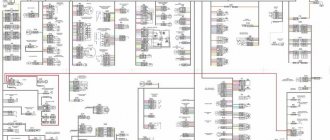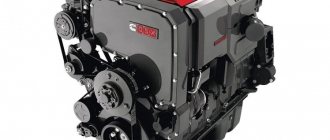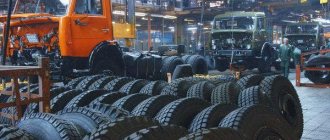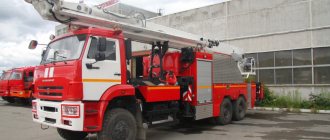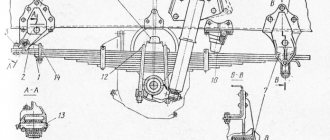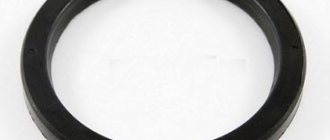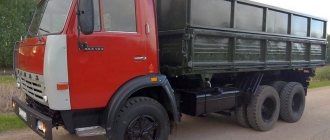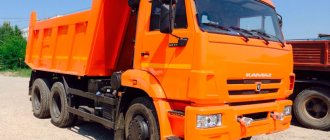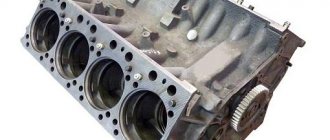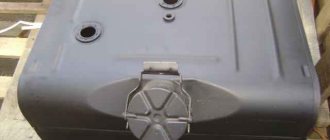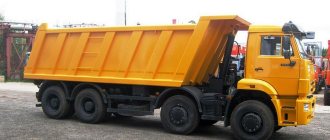KamAZ 5320 is one of the most popular three-axle flatbed trucks. The model has a 6x4 wheel arrangement and can serve as a tractor for towing trailers.
All mass production lasted 25 years. During this time, trucks from the Kama Automobile Plant were distributed to almost all areas of activity, where they often carried out and are now carrying out regular and rather intense work.
The KamAZ 5320 model is the debut truck of the Kama Automobile Plant. Even then, it was distinguished by its unpretentiousness and fairly high reliability, which ensured its great popularity, first in the country, and later in the world. The trucks were also exported to 42 countries.
In 2001, this model was discontinued from mass production. Despite this, the truck remains quite relevant today, since it has excellent technical and operational characteristics. Nowadays, many different organizations have a number of used KamAZ 5320 in their fleet.
Story
In 1968, the ZIL enterprise received an order from the USSR Ministry of Automotive Industry to develop a family of heavy three-axle trucks equipped with diesel power plants. But mass production was later to be transferred to a new plant.
The company's designers began developing the model in a short time. The models for creating a domestic truck were foreign trucks purchased by the company, with both hood and cabover cabs. Of all this equipment, the plant gave preference to the American International 220. This was influenced by several reasons, one of which was the knowledge of the chief designer of ZIL of this manufacturer’s products.
The International 220 truck had a cabover layout, a quite comfortable cabin for those years, hydraulic power steering, a powerful diesel power plant, a five-speed manual transmission, which included a front splitter, as well as a fairly effective braking system. In terms of quality, this truck was without a doubt an excellent example. The domestic car was equipped with a different cabin, into which 4 headlights were integrated. The new cabin also featured more rectangular lines and a sleek grille. But there are still some similar outlines.
The first prototype was presented by Soviet specialists in 1969. The truck was given the name ZIL 170. The site on the highway connecting Uglich and Rybinsk was chosen as a place for various tests.
In 1970, construction of a new plant began for serial production of the ZIL 170. This enterprise was supposed to combine different productions, including the production of engines and other components and assemblies.
Simultaneously with the construction of the plant, many tests were carried out. During this entire period, the developers tested more than 50 modified versions. As a result of the main tests in 1970, which were carried out by the Yaroslavl Motor Plant, various shortcomings were identified, quite a lot of them. In this regard, a global modernization was carried out for the truck, and the already modified versions were assembled by the Kama Automobile Plant.
In 1974, a new power plant was developed for the truck. In 1975, mass production began, and the model was assigned the already familiar KamAZ 5320 index. In just one year, the Kama Automobile Plant was able to produce more than 5 thousand trucks, which almost immediately found their use throughout the country.
The first version of KamAZ 5320 was made in the form of a large tractor with an onboard cargo platform and a cabin with three seats. Access to the engine and other elements was provided by a special mechanism that allowed the cab to be tilted forward, which is present even on modern trucks. Below it is a diesel engine, the maximum power of which reaches 210 horsepower. In addition to quite a lot of power, this engine was distinguished by impressive traction, which made it possible to transport large volumes of cargo without much difficulty. For its time, the cabin had good thermal insulation and fairly comfortable working conditions.
The development of the KamAZ 5320 truck turned out to be very successful and in demand. Already in the first years of production, the equipment gained great popularity, and by 1979, the Kama Automobile Plant produced more than 100 thousand cars, which is a very impressive mark. In 1981, the plant developed all-wheel drive trucks.
In 1984, the designers developed a new prototype, which was designed to run on both diesel fuel and liquefied gas. A year later, this modification underwent many test runs, as a result of which it became clear that the use of gas-diesel technology has a positive effect not only on efficiency, but also on the smoke and noise of the engine.
In 1987, the Kama Automobile Plant began production of two new models, called KamAZ 53208 and KamAZ 5312. Both modifications were equipped with gas-diesel power plants. The engine used has a maximum output power of 210 horsepower.
Until 2001, this model was refined many times and received various changes, both in construction and design. But it is worth noting that all the improvements made were quite small. Later, the truck became obsolete and its mass production ceased completely. It was then replaced by a more modern model.
Transmission
The situation with the checkpoint is similar. Different versions have different boxes.
- 5 speed – model 14
- 5 speed with front splitter (model 15)
Cardan transmission – two consecutive cardan shafts with an intermediate support. The drive axle is not produced by the Kama Automobile Plant. This is a development of the Hungarian company “RABA” model A-111.49-3300. It has a planetary gearbox with a locking differential. Gear ratios 6.67 or 6.27
Modifications
Among the main modifications of this truck, the following models should be highlighted:
Modification of KamAZ-532007.
It is the same flatbed truck as the standard version, but it is intended for use in areas with a tropical climate;
Modification of KamAZ-53201.
This chassis is used to build various special vehicles. For example, on the basis of this modification, fuel trucks, fire fighting equipment, concrete mixers, road cleaning equipment, and a dump truck designed for work in rural areas were built. It is worth noting that the dump truck received the KamAZ index 55102. The chassis itself, on which the KamAZ 7403.10 engine was installed, had the KamAZ index 53211;
Modification of KamAZ-53202.
It is a flatbed truck with a wheelbase increased to 3690 mm. The total length of the model has increased to 6100 millimeters. The carrying capacity remains the same, namely 8000 kilograms;
Modification of KamAZ-53212.
It is an analogue of the previous modification. A version was released in 1980. The length of the wheelbase and the truck as a whole remained unchanged and are the same 3690 and 6100 millimeters. However, the maximum carrying capacity has been increased, which is now 10,000 kilograms;
Modification of KamAZ-53208.
It is analogous to a standard flatbed truck. It features a gas-diesel power plant, the maximum power of which reaches 210 horsepower;
Modification of KamAZ-5312.
Just like the previous one, it has a gas-diesel engine with a capacity of 210 horsepower.
In addition to all this, other modifications were created on the basis of KamAZ 5320, including:
- KamAZ 551. It is a tractor with a flatbed body;
- KamAZ 5325. It is a tractor with a flatbed body and an extended wheelbase;
- KamAZ 5401. This version is a truck tractor. Designed to work as part of a road train.
Update
Some time after the release of the KamAZ-5320, engineers at the Kama Automobile Plant developed other trucks based on it:
- Truck tractor 5410 , which is capable of transporting a semi-trailer with a load capacity of 13.5 thousand kg. The weight of the loaded trailer is 19,000 kg.
- Dump truck 5511 – can withstand up to 10 tons. The machine is equipped with a metal bucket-shaped platform, there is no tailgate. Loaded with construction materials and industrial cargo.
- Tractor 53112. Can transport up to 10,000 kg, has an enlarged wheel arrangement and a large platform. The trailer weight for this model has increased to 20 tons.
- KamAZ-55102 is a dump truck for working with a trailer (mainly GKB 9527).
Cabin
KamAZ 5320 was equipped with a metal cabin designed for three people (driver and two passengers). In general, the cabin has quite a lot of free space, but it still does not provide a sleeping place. However, this did not affect the popularity in any way. Moreover, in terms of comfort for the driver and passengers, the KamAZ 5320 was practically the standard among trucks of that era.
In many of its parameters, this truck was superior to most similar models. None of the cars produced at that time had such excellent sound and thermal insulation, seat belts, and a driver’s seat with the ability to adjust the driver’s weight. It is worth noting that the seat was sprung, which further increases comfort when working.
But in addition to the advantages, many drivers also noted the disadvantages of the cabin. For example, the steering wheel is quite large, and the gear lever is not very conveniently located. But still, these are not such significant shortcomings, since you can get used to them quite quickly.
Inside the cab there are all the necessary instrumentation and indicators, thanks to which the driver receives information about the current condition of the truck. The dashboard houses a signal system with excellent visibility of dials and switches. It should be noted that compared to other similar trucks, KamAZ 5320 was safer, both for the driver and passengers.
Transmission, clutch KamAZ 5325
Kamaz 5325 is equipped with a hydraulic drive with hydraulic booster. Clutch type: single-disc, diaphragm. Clutch model MFZ 430.
Clutch mechanism mod MFZ - 430: 1 - drive shaft; 2 - flywheel; 3 — driven disk; 4 — pressure disk; 5 - thrust ring; 6 - diaphragm; 7 — clutch casing; 8 — clutch release; 9 — clutch release fork; 10 — clutch release fork shaft; 11 — restrictive ring; 12 — gearbox; 13 — pneumatic hydraulic booster.
Specifications
Engine
The manufacturer used a V-shaped eight-cylinder unit as the power plant for the KamAZ 5320, the maximum power of which was initially 180 or 210 horsepower, depending on the version of the truck. But the working volume remained the same and amounted to 10.85 liters. This engine also has a high-pressure V-spool fuel pump. The development of the engines used was carried out by the Yaroslavl Motor Plant.
As practice has shown, the engine fully maintains its functioning even in rather difficult operating conditions. For example, it may be too high (+50 degrees) and too low (-40 degrees) ambient temperatures. The engine was given this opportunity by an efficient cooling system equipped with a hydraulic coupling and several thermostats.
In addition, the engine has an air purification system, which includes automated suction of dust and dirt. To operate in sub-zero temperatures, a preheater and an electric flare system are available for the engine. This solution ensures not only easy starting of the engine, but also its smooth operation throughout the entire time.
The manufacturer also made several improvements to this power unit. As a result, it was possible to reduce fuel consumption. It is worth noting that in this parameter the models of the first years of production and later ones differ quite noticeably. Reduced fuel consumption has made the KamAZ 5320 an even more competitive truck on the market, even among foreign models. In addition, the engine's maximum power was increased.
As standard, the truck is equipped with two fuel tanks of 250 and 175 liters.
Characteristics of KamAZ-740.11-240:
- Working volume – 10.85 l;
- Maximum power – 240 hp;
- Maximum torque – 834 N.m. (at 1200-1400 rpm);
- Cylinder diameter – 120 mm;
- Piston stroke – 120 mm;
- The compression ratio in the combustion chamber is 16;
- Cooling – liquid;
checkpoint
The KamAZ 5320 transmission system includes a five-speed manual gearbox and a two-stage divider. The gearbox has synchronizers, but not in all gears.
The truck is also equipped with a double-disc friction clutch, complemented by a hydropneumatic booster.
Brake system
Like many other trucks, this model is equipped with a braking system, which can be divided into 4 types, namely main, auxiliary, spare and parking. The brake mechanisms themselves are represented by drums with pads inside, located on each wheel. The brakes are operated by a pneumatic drive. It is worth noting that there are two circuits in the system.
In the case of the main brake, the action on the front axle and rear axle mechanisms was carried out separately, which provided the equipment with effective braking.
The brake mechanisms of the rear axles are equipped with spring energy accumulators, which act as a parking brake. Speaking of parking, only the rear wheels were locked, like any other car.
Most of the elements of the auxiliary brake system were mounted in the exhaust pipes of the muffler. The functioning of such a brake was carried out by back pressure created by the release of exhaust gases through dampers that block the cross-section of the passage.
If the truck's primary brake system fails, the vehicle can be stopped using the backup parking brake.
The main brake system is controlled by a pedal connected by various rods and levers to a two-section brake valve.
Near the driver's seat there is a special lever responsible for the parking brake. However, this lever also activated the spare brake system.
As for activating the auxiliary brake, this process is performed by a push-button switch located on the floor under the steering column.
Chassis
This truck is based on a rigid stamped riveted frame. Its design is represented by two channel spars that connect several cross members. The front part of the frame has a buffer, and a tow hook is installed at the ends of each side member. The manufacturer equipped the rear cross member with a towing device that has reliable rubber parts that promote high-quality bilateral shock absorption. The use of a towing device made it possible to use the truck as a tractor for towing various trailers.
The design of the front suspension of the KamAZ 5320 contains semi-elliptical springs with sliding rear ends. In addition to them, bi-directional hydraulic telescopic shock absorbers were installed. At the rear, the model has a balancer suspension, also equipped with semi-elliptical springs, which have sliding rear and front ends. It is worth noting that a similar suspension solution is also observed in more modern families of KamAZ brand trucks.
Dimensions:
- Full length (standard) - 8395 mm.
- Total length (modification) - 7435 mm.
- Full width – 2500 mm.
- Cabin height – 2830 mm.
- The height of the awning is 3350 mm.
- Wheelbase length – 3190 mm.
- The length of the rear bogie wheelbase is 1320 mm.
- Front track width – 2010 mm.
- The rear track width is 1850 mm.
- Ground clearance – 345 mm.
- Loading platform length – 5200
- Load platform width – 2500
- The width of the cargo platform with awning is 1975 mm.
- Side height – 500 mm
- The height of the extension sides is 355 mm.
Peculiarities
KamAZ 5320 was produced for quite a long time and during this entire period almost every driver knows it. Although at one time this truck was not up to par with European-made models, at that time it was without a doubt one of the best on the domestic market. Many drivers note a significantly increased level of comfort, reliability, and maintainability. As for the penultimate one, an excellent example is the fact that even today it is not uncommon to see a serviceable KamAZ 5320 on the roads.
The popularity of the model, in principle, has not fallen much even now. This is explained not only by the qualities already listed, but also by its affordability compared to other foreign options. In addition, the three-axle machine performs quite well in difficult road conditions, which makes it especially profitable in rural areas and on rough terrain.
Every driver who has ever dealt with such equipment can handle the repair of this truck without much difficulty. As for spare parts, even now it is not difficult to find the necessary part for it, and this despite the fact that its mass production completely ceased in 2001.
One of the main disadvantages, especially these days, is the rather high fuel consumption. According to this indicator, the truck is significantly inferior to its modern analogues. Among other shortcomings, we should highlight a certain fragility of the wheel arches, fender liners and flaps, with which various breakdowns often occur, which can only be solved by replacing these elements. Since the KamAZ 5320 is the debut vehicle of the brand, its suspension has become very outdated over the years, not to mention the present time. Due to this, the truck cannot offer a good ride. The turning radius of the model is very large, which, combined with low maneuverability, makes its control very difficult in conditions of limited working space.
Price
Now it is impossible to purchase this truck not only in new technical condition, but even with low mileage. This can only be explained by its long-standing cessation of mass production, as described earlier. But there are quite a lot of used options on the market, and at a very affordable price.
The average cost of equipment produced between the 1980s and the early 1990s varies from 280 thousand to 320 thousand rubles. Models produced before 1995 have an average cost of 400 thousand to 490 thousand rubles. Well, until 2001, the price ranges from 650 thousand to 710 thousand rubles.
Of course, there are cheaper options, but these, as a rule, are either in very poor technical condition or are not running at all.
Conclusion
What conclusions can there be? Only positive ones, because the car is still in service today. The KamAZ 5320 device is reliable and practical. A car with a good, powerful power unit and tractor capabilities. It seems to us that this is an excellent example of the Soviet automobile industry. Victories in various competitions, world fame - isn't that enough? The technical characteristics of the KamAZ 5320 vehicle are impressive even today. We think that this option, a truck, will serve for many more decades, transporting various cargoes along the routes of the post-Soviet space.
Reviews from owners and drivers
- This bucket of bolts will be useful for a novice car mechanic, since repairing it is like playing with a construction set for adults. Seriously, the Kamaz 5320 really requires constant repairs. I didn't like the car right away. And yet I must admit, this was my first experience of owning a heavy truck. For the sake of fairness, advantages should also be noted. Among them is a powerful heater. In winter, the cabin is always warm, also thanks to the engine. Excellent visibility and directional stability are thanks to the center differential lock. There are many more disadvantages. Just in case, you should always carry a binding wire and a piece of oxygen hose with you, since the pneumatics of the car are poorly implemented, to put it mildly. Due to rubbing, the main tubes quickly become unusable, which, by the way, are located in hard-to-reach places. The pneumatic crane is not designed for heavy loads, and therefore is one of the first to fail. To tow the car, you will need to remove the front bumper, otherwise you will not be able to hook the rigid coupling device onto the hooks. And you also need to be able to supply air during towing. The spare tire is a separate issue. He tries to break away because it is positioned poorly. There is a high probability that if the spare tire comes off, it will fall on the rear wheels, which can lead to an accident. The dashboard is a complete mess. It is scattered in such a way that the steering wheel overlaps the instruments. There is no airflow in the side windows, and the middle seat has no shock absorbers - it’s uncomfortable to sit. Based on the above, it is unlikely that you will be able to work on a KamAZ purely as a driver, since you will also need the skills of a car mechanic. For him, repairing such a car will be akin to a construction kit for adults.
- Kamaz 5320 is a car from the last century. Both morally and technically. Despite this, with proper care, the car will please you with its reliability, but will disappoint you with its poor cross-country ability. It should be noted that this car was considered a breakthrough in the USSR. I had the opportunity to work on it in those years. Relatively modern design and a cabin with thoughtful driver ergonomics, a powerful heater, lightweight handling and good visibility. On the other hand, you can once again complain about the mediocre cross-country ability and handling on snowy or icy surfaces, as well as on wet primers. Yes, I know that the 5320 was designed for use on asphalt or concrete surfaces, but not for off-road use. And yet, from such a legendary car I would like some versatility. The car was considered reliable as long as the USSR had a 10-year planned operation program for these cars, and then they were written off. This is precisely what explains the fact why, starting in the 90s, private owners began to complain about these cars. I worked on 5320 during the Soviet years, as well as in the early 2000s. The old truck was constantly falling apart, and this was not even due to the natural aging of components. Overall, it was a good car that made a significant contribution to the history of a large country.
- Kamaz 5320 can be praised for many things and at the same time forget about its shortcomings. And all because for me this is the main source of income, bringing a stable profit. I am a private entrepreneur, I have been working in cargo transportation for ten years. 5320 is inexpensive to operate compared to foreign analogues. I have a version with an 11-liter 210-horsepower diesel engine, which consumes 35 liters per 100 km. Wheel arrangement – 6x4. Conveniently, the cargo platform has opening side and rear sides. The cabin is spacious enough to seat three people. The all-metal cabin is implemented successfully in terms of visibility and ergonomics, but the body quickly rusts and needs to be treated regularly. There is space in the cabin for attaching seat belts.
- I have a used KamAZ 5320 in operation since 2012. The car is well preserved, despite the mileage of 200 thousand km. Reliable, structurally simple and cheap car. Spare parts for it can be found in a wide range of dismantling shops. Of course, not without its shortcomings, but the car is not bad. The Kamaz 5320 is ideal for short-range transportation. The high-torque 210-horsepower 11-liter diesel engine confidently takes the climb. The manual transmission could be more precise, but it will do. The level of ergonomics in the cabin is from the 80s, but you can get used to it. I improved the sound insulation and installed more comfortable seats with more lateral support, as well as a longer cushion and backrest. In the old, worn-out seats, my back quickly became numb. In winter, the old Soviet heater still works effectively and is easy to maintain. Load capacity of about 20 tons is a good indicator for urban cargo transportation. The bottom can be serviced without a pit, so repairs are possible even on a long journey, on the side of the road, etc. The car consumes 35 liters.
- Kamaz 5320 manufactured in 1998, in operation since 2010. I bought this workhorse with 230 thousand km on it. The car is easy to maintain, and I also have my own truck repair shop. There are suppliers of the necessary spare parts. So I decided to try to start a cargo transportation business. Fortunately, I came across a successful copy. There was no need to overhaul the engine or transmission. Updated the body and chassis, installed additional sound insulation and good luck, as they say. I also installed new seats. The powerful 210-horsepower engine pulls well on inclines - this is the most important thing for a truck, especially if you are carrying 12 tons of cargo. The engine is combined with a reliable transmission, the oil level of which must be checked regularly. The machine is capable of pulling trailers. In general, a universal thing for all times.
- I own a 1996 Kamaz. At one time, it was an indispensable truck for short and medium distance transportation. However, now this is also a good option for a novice entrepreneur. The 5320 has a decent load capacity of 12 tons and a high-torque 210-horsepower diesel engine with a volume of 11 liters. It is very noisy if the sound insulation of the interior and hood is not improved. In general, a lot of things in this car need to be improved on their own. But I must admit, after foreign cars it is very difficult to drive this car - you have to get used to it again, especially when the car is loaded to capacity. There is a reduction gear and axial air blocking, which are necessary when moving uphill with loads. The stove blows efficiently, but what it blows is that there are drafts all around, it’s good that it always blows hot air. There are no problems with it. It is inconvenient to lift the cabin, because the engine is located under it. Comfort in the cabin is specific due to the spartan seating position, but these are all costs of the profession - you can get used to it.
- I have a Kamaz 5320 since 2014. The car was produced in 1990. At the start of operation, the mileage was 240 thousand km. The car was at full speed, and then began to quickly crumble for no reason. Fortunately, the 11-liter engine and gearbox are the most reliable components in this car. With proper care, the chassis and body will not cause any complaints, but only for the time being. In any case, the body will be annoying due to the rapid appearance of corrosion. I am glad that at least you can load 12-13 tons, and at the same time the body will not sit on the bumpers. The 200-horsepower diesel engine has enough thrust throughout the entire rev range. Actual fuel consumption is 35 liters per 100 km.

